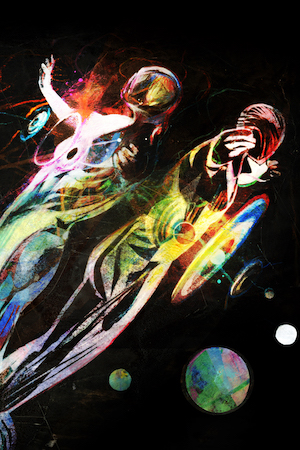Three decades ago, in the wake of the success of Star Trek: The Next Generation in first-run syndication, there was a plethora of shows that were released in that form—not beholden to a particular network, but sold to individual markets separately. Into that boom stepped Warner Bros., who formed a sort-of syndicated network: the Prime Time Entertainment Network, which would syndicate a series of shows to various markets: Kung Fu: The Legend Continues, Pointman, Time Trax, a few miniseries, documentaries, and TV movies, and a science fiction show from the mind of J. Michael Straczynski: Babylon 5.
Straczynski had an ambitious plan: to do a science fiction show that would succeed on a reasonable budget and also that would tell a complete story—a novel in television form, as it were. While such serialized storytelling is de rigeur now, it was very rare on television in the 1990s, seen mostly in places like soap operas, as well as the occasional drama like Hill Street Blues.
B5 was planned as a five-year arc. Straczynski simplified budget concerns in two ways. One was to have the action all in the same location rather than hopping from planet to planet, as most screen science fiction shows did.
Another was to do the effects entirely via a process that is almost universal in the 2020s but which was virtually unheard of in the 1990s: Computer Generated Images. B5 was a pioneer in CGI, using the Video Toaster for the Amiga to create the visual effects rather than models and miniatures. This meant that episodes of B5 could be produced for less than half the budget of an episode of TNG.
B5 debuted in 1993 with a television movie, The Gathering. It had the misfortune to air the same week as the World Trade Center bombing in New York in 1993, which put the antenna atop the WTC out of commission, keeping the movie from being broadcast in certain parts of the New York metropolitan area. Despite this ratings hit, the movie did well enough for Warner Bros. to order a series, which debuted exactly thirty years ago on PTEN.
Straczynski’s five-year plan hit a few roadblocks, including losing his main protagonist. Series lead Michael O’Hare, who played the Babylon 5 station’s commanding officer Jeffrey Sinclair, was suffering from severe mental illness, and departed the show after the first season to seek treatment. (At O’Hare’s request, Straczynski kept the real reason for O’Hare’s departure secret until the actor’s death in 2012.)
Other real-world issues with various actors caused rewrites and rejiggers of the plotline, but perhaps the biggest was PTEN’s collapse in 1997, with B5 still in its fourth season. Straczynski wound up cramming a lot of the planned storyline for seasons four and five into season four—only to then have the show rescued by TNT (also at this stage owned by Warner Bros.’ parent company, Time Warner), which not only aired the fifth season, but also commissioned several TV movies and a spinoff series. Alas, the spinoff, Crusade, only lasted one season. Straczynski created another pilot movie, Legend of the Rangers, for what was then called the Sci-Fi Channel, but it was not picked up for a series.
In addition to being a CGI pioneer, Straczynski’s B5 was also an early forerunner of viral Internet marketing, using CompuServe, Usenet, and especially the GEnie bulletin board to create buzz for the show. In tribute to the support of the show prior to its airing on GEnie, Babylon 5 station’s coordinates were Grid Epsilon 470/18/22. Grid Epsilon was a reference to GE, the company that ran GEnie, while B5’s bulletin board was on page 470 (one of the three Science Fiction Roundtables, specifically the one dedicated to screen productions), category 18, topic 22. (Your humble rewatcher was a regular presence on GEnie in those days, under the username KEITH.D.)
In September 2021, Straczynski announced that he was rebooting B5. That’s still in development at the moment, delayed at least in part by the writers’ and actors’ strikes of 2023. Also in 2023, Warner Bros. released an animated film, The Road Home.
Partly in honor of this reboot, partly in honor of the TV series’ thirtieth anniversary, and partly because I’ve been wanting to rewatch the show for the first time since its initial airing, next Monday will kick off The Babylon 5 Rewatch here on Reactor. We’ll be covering everything, starting with The Gathering, continuing to the five seasons of the TV series, the one season of Crusade, and each of the various movies, from In the Beginning all the way to The Road Home. I might cover some ancillary material, too…
Like my rewatches of the first five Star Trek shows, of the 1966 Batman, and of the Stargate franchise, each entry will be broken down into categories. A few will be familiar, though most will be new.
It was the dawn of the third age… A summary of the plot.
Nothing’s the same anymore. Jeffrey Sinclair’s role in the story.
Get the hell out of our galaxy! John Sheridan’s role in the story.
I’m not subtle, I’m not pretty. Matthew Gideon’s role in the story.
Ivanova is God. Susan Ivanova’s role in the story.
Never work with your ex. Elizabeth Lochley’s role in the story.
The household god of frustration. Michael Garibaldi’s role in the story.
If you value your lives, be somewhere else. In general, the role of the Minbari in the story, as well as the specific roles of Delenn, Lennier, and the Grey Council.
In the glorious days of the Centauri Republic… In general, the role of the Centauri Republic in the story, as well as the specific roles of Londo Mollari and Vir Cotto.
Though it take a thousand years, we will be free. In general, the role of the Narn Regime in the story, as well as the specific roles of G’Kar and Na’Toth.
We live for the one, we die for the one. In general, the role of the Rangers in the story, as well as the specific role of Marcus Cole.
The Corps is mother, the Corps is father. In general, the role of telepathy, telepaths, and Psi-Corps in the story, as well as the specific roles of Lyta Alexander, Talia Winters, John Matheson, and Alfred Bester.
Never contradict a technomage when he’s saving your life—again. In general, the role of technomages in the story, as well as the specific role of Galen.
The Shadowy Vorlons. The role played by one or both of the Shadows and the Vorlons, the two ancient foes whose conflict makes up the tapestry of much of the series, in the story, particularly the uses of Kosh and Morden.
Looking ahead. B5 made copious use of foreshadowing by way of flash-forwards and prophecies, and this category will show when they’re used, and also when they later come to fruition (often not in the way you expect).
No sex, please, we’re EarthForce. A chronicle of the romantic and/or sexual exploits seen in the story.
Welcome aboard. The guest stars in the story.
Trivial matters. Various bits of trivia, ephemera, connections, revelations, etc. seen in the story.
The echoes of all of our conversations. A particularly good quote from the story.
The name of the place is Babylon 5. A review of the story.
Note that this rewatch will not have a 1-10 rating of each story. My least favorite part of prior rewatches has been having that silly rating system, which removes all nuance from the words that appear above it. I inherited it from the first Star Trek Re-Watch that appeared on this site back from 2009-2011, so I reluctantly continued it through all the Trek rewatches. I managed to not have to use it for the Great Superhero Movie Rewatch or the Stargate Rewatch, and I’m just as happy to avoid it here.
It’s possible I will think of other categories to add. I tried to anticipate all the various changes we’ll see throughout the various series, but I may have missed something that is worth having its own category. And I’m aware that not every character gets their own category, and in response I’ll just say that Jim Kirk, Jean-Luc Picard, William Riker, Miles O’Brien, Julian Bashir, and Chakotay are among the major characters in the Trek rewatches that didn’t get their own categories. It happens.
We’ll be back next week with The Gathering!










